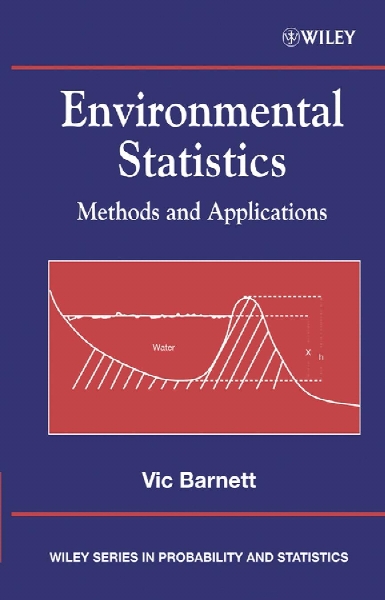Environmental statistics : methods and applications
- نوع فایل : کتاب
- زبان : انگلیسی
- مؤلف : Vic Barnett
- ناشر : Chichester, West Sussex, England ; Hoboken, NJ : J. Wiley,
- چاپ و سال / کشور: 2004
- شابک / ISBN : 9780471489719
Description
Chapter 1 Introduction 1 1.1 Tomorrow is too Late! 2 1.2 Environmental Statistics 2 1.3 Some Examples 5 1.3.1 ‘Getting it all together’ 5 1.3.2 ‘In time and space’ 8 1.3.3 ‘Keep it simple’ 10 1.3.4 ‘How much can we take?’ 12 1.3.5 ‘Over the top’ 14 1.4 Fundamentals 16 1.5 Bibliography 18 PARTI EXTREMAL STRESSES: EXTREMES, OUTLIERS, ROBUSTNESS 21 Chapter 2 Ordering and Extremes: Applications, models, inference 23 2.1 Ordering the Sample 24 2.1.1 Order statistics 25 2.2 Order-based Inference 26 2.3 Extremes and Extremal Processes 32 2.3.1 Practical study and empirical models; generalized extreme-value distributions 37 2.4 Peaks over Thresholds and the Generalized Pareto Distribution 40 Chapter 3 Outliers and Robustness 45 3.1 What is an Outlier? 45 3.2 Outlier Aims and Objectives 46 3.3 Outlier-Generating Models 49 3.3.1 Discordancy and models for outlier generation 49 3.3.2 Tests of discordancy for specific distributions 51 3.4 Multiple Outliers: Masking and Swamping 53 3.5 Accommodation: Outlier-Robust Methods 54 3.6 A Possible New Approach to Outliers 55 3.7 Multivariate Outliers 56 3.8 Detecting Multivariate Outliers 58 3.8.1 Principles 59 3.8.2 Informal methods 60 3.9 Tests of Discordancy 66 3.10 Accommodation 68 3.11 Outliers in linear models 70 3.12 Robustness in General 72 PART II COLLECTING ENVIRONMENTAL DATA: SAMPLING AND MONITORING 75 Chapter 4 Finite-Population Sampling 77 4.1 A Probabilistic Sampling Scheme 78 4.2 Simple Random Sampling 79 4.2.1 Estimating the mean, X 81 4.2.2 Estimating the variance, S2 82 4.2.3 Choice of sample size, n 84 4.2.4 Estimating the population total, XT 85 4.2.5 Estimating a proportion, P 86 4.3 Ratios and Ratio Estimators 89 4.3.1 The estimation of a ratio 90 4.3.2 Ratio estimator of a population total or mean 92 4.4 Stratified (simple) Random Sampling 96 4.4.1 Comparing the simple random sample mean and the stratified sample mean 99 4.4.2 Choice of sample sizes 100 4.4.3 Comparison of proportional allocation and optimum allocation 102 4.4.4 Optimum allocation for estimating proportions 103 4.5 Developments of Survey Sampling 103 Chapter 5 Inaccessible and Sensitive Data 105 5.1 Encountered Data 106 5.2 Length-Biased or Size-Biased Sampling and Weighted Distributions 107 5.2.1 Weighted distribution methods 108 5.3 Composite Sampling 112 5.3.1 Attribute Sampling 112 5.3.2 Continuous variables 115 5.3.3 Estimating mean and variance 115 viii CONTENTS 5.4 Ranked-Set Sampling 117 5.4.1 The ranked-set sample mean 119 5.4.2 Optimal estimation 122 5.4.3 Ranked-set sampling for normal and exponential distributions 124 5.4.4 Imperfect ordering 126 Chapter 6 Sampling in the Wild 131 6.1 Quadrat Sampling 131 6.2 Recapture Sampling 132 6.2.1 The Petersen and Chapman estimators 133 6.2.2 Capture–recapture methods in open populations 136 6.3 Transect Sampling 138 6.3.1 The simplest case: strip transects 139 6.3.2 Using a detectability function 142 6.3.3 Estimating f (y) 144 6.3.4 Modifications of approach 146 6.3.5 Point transects or variable circular plots 147 6.4 Adaptive Sampling 148 6.4.1 Simple models for adaptive sampling 149 Part III EXAMINING ENVIRONMENTAL EFFECTS: STIMULUS–RESPONSE RELATIONSHIPS 151 Chapter 7 Relationship: regression-type models and methods 153 7.1 Linear Models 154 7.1.1 The linear model 156 7.1.2 The extended linear model 158 7.1.3 The normal linear model 160 7.2 Transformations 161 7.2.1 Looking at the data 162 7.2.2 Simple transformations 166 7.2.3 General transformations 168 7.3 The Generalized Linear Model 171 Chapter 8 Special Relationship Models, Including Quantal Response and Repeated Measures 175 8.1 Toxicology Concerns 176 8.2 Quantal Response 178 8.3 Bioassay 180 8.4 Repeated Measures 182 CONTENTS ix Part IV STANDARDS AND Regulations 189 Chapter 9 Environmental Standards 191 9.1 Introduction 191 9.2 The Statistically Verifiable Ideal Standard 193 9.2.1 Other sampling methods 195 9.3 Guard Point Standards 199 9.4 Standards Along the Cause–Effect Chain 200 PartV AMANY-DIMENSIONAL ENVIRONMENT: SPATIAL AND TEMPORAL PROCESSES 203 Chapter 10 Time-Series Methods 205 10.1 Space and Time Effects 205 10.2 Time Series 208 10.3 Basic Issues 211 10.4 Descriptive Methods 213 10.4.1 Estimating or eliminating trend 214 10.4.2 Periodicities 217 10.4.3 Stationary time series 218 10.5 Time-Domain Models and Methods 219 10.6 Frequency-Domain Models and Methods 225 10.6.1 Properties of the spectral representation 225 10.6.2 Outliers in time series 227 10.7 Point Processes 230 10.7.1 The Poisson process 230 10.7.2 Other point processes 232 Chapter 11 Spatial Methods for Environmental Processes 235 11.1 Spatial Point Process Models and Methods 236 11.2 The General Spatial Process 240 11.2.1 Predication, interpolation and kriging 241 11.2.2 Estimation of the variogram 245 11.2.3 Other forms of kriging 248 11.3 More about Standards Over Space and Time 252 11.4 Relationship 253 11.5 More about Spatial Models 255 11.5.1 Types of spatial model 256 11.5.2 Harmonic analysis of spatial processes 257 x CONTENTS 11.6 Spatial Sampling and Spatial Design 258 11.6.1 Spatial sampling 258 11.6.2 Spatial design 260 11.7 Spatial-Temporal Models and Methods 263 References 267 Index 285


